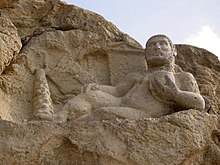Heracles of Bisutun
The Heracles of Bisutun is a rock-cut high relief of the Greek demigod . Bisutun ( Behistan ) is located about 30 kilometers east of Kermanshah in western Iran . The place is famous for its Achaemenid rock carvings. But there are also later reliefs here. Heracles is shown lying on a lion's skin. An inscription dates the statue to 148 BC. BC, shortly before the end of the Seleucid (Greek) rule in this region. In ancient Iran, rock carvings were a widespread art form. Elamite , Achaemenid andSasanian rock carvings are well known and were a favorite means of self-portrayal for rulers. By contrast, there is only this single rock-cut sculpture from the period of Greek rule in Iran.
The relief was discovered during road construction work in 1958, but was headless at the time. The head was only found a few days later. Today, however, only a copy can be seen on site, while the original head is in custody. Bisutun, including this sculpture, has been a Unesco World Heritage Site since 2017.
The 147 cm long image of the demigod shows him leaning on the rock with a cup in his hand. His weapons are next to him. Arrows hang from a tree. His club is shown next to his feet. Behind Heracles is a tablet with the following Greek inscription:
- 1 ἔτους δξρ᾽, μηνὸς
- 2 Πανήμου, Ἡρακλῆν
- 3 Καλλίνικον
- 4 Ὑάκινθος Πανταύχου
- 5 ὑπὲ[ρ] τῆς Κλεομένου
- 6 τοῦ ἐπὶ τῶν ἄνω
- 7σ[ατρ]απειῶν σωτηρίας
translation
- 1 In the year 164, in the month
- 2 Panemos, [was erected] Heracles
- 3 Kallinikos (splendidly triumphant)
- 4 by Hyakinthos son of Pantauchus,
- 5 for the welfare of Cleomenes,
- 6 of the commander of the superiors
- 7 satrapies.
The inscription dates the statue to June 148 BC. and inscribes the statue as Herakles Kallinikos – Heracles gloriously triumphant . She goes on to say that Hyakinthos, son of Pantauchus, dedicated it to Cleomenes, satrap of the Upper Satrapies . Kallinikos, the epithet of Herakles, is also attested as such among Seleucid kings. None of the persons named here are known from other sources. Remains of an Aramaic inscription have also been preserved below the Greek inscription.
Originally, the relief may have been inside a sanctuary. Two Parthian reliefs survive nearby, suggesting that the cult continued into the Parthian period. Fragments of Ionic bases and pilasters found in the area may have belonged to this sanctuary. They also occupy a building in the Hellenistic style.
The relief is of art-historical importance, since its exact dating makes it a fixed point for Seleucid works of art, of which only a few are known. At Bisutun there are rock reliefs of different epochs. The inscription of the Achaemenid king Darius I is the best known. There is also a relief from the time of the Parthian Empire . The depiction shows a mixture of Hellenistic and Iranian elements. The depiction of the demigod is reminiscent of those from Pergamon . The character's robust style is more Iranian, though. The execution of the work appears provincial. Daniel Schlumberger describes the work as coarse. Also, the representations of a bow, arrows and a quiver are more typical of the Iranian world. The shape of the stele with the inscription, on the other hand, is reminiscent of the royal inscriptions of the Seleucids.
In the Iranian area, Herakles was equated with Verethragna /Bahram. His cult was extremely popular in this and the following time. The statue certainly represents the Interpretatio Graeca of this Iranian deity.
literature
- Heinz Luschey : The Seleucid figure of Heracles. In: Wolfram Kleiss, Peter Calmeyer (eds.): Bisutun. Excavations and research in the years 1963-1967 (= Tehran Research Vol. 7). Gebr. Mann, Berlin 1996, pp. 59–60.
- Rolf Strootman, Hellenism and Persianism in Iran: Culture and Empire after Alexander the Great , In: Dabir 7 (2020), p. 212.
itemizations
- ↑ It ended in 140/139 BC. when the Parthian king Mithridates I conquered the whole region.
- ↑ Behistun, other monuments - Livy. Retrieved January 26, 2022 .
- ↑ UNESCO World Heritage Centre: Bisotun. Retrieved January 26, 2022 (English).
- ^ HIB | Greek text - Parthian Sources Online. Retrieved January 26, 2022 (English).
- ↑ The year refers to the Seleucid era .
- ↑ a b c Strootman: In: Dabir 7 (2020), p. 212.
- ↑ Philip Huyse: The Use of Greek Language and Script in Inscriptions from the Iranian World , in: Werner Eck and Peter Funke (eds.): XIV Congressus Internationalis Epigraphiae Graecae et Latinae. 27-31 Augusti MMXII. Files , Vol. 4: Public - Monument - Text. Berlin/Boston 2014 ISBN 978-3-11-037496-4 , p. 174.
- ↑ Bisotun .
- ↑ a b Daniel Schlumberger : The Hellenized Orient. Greek and Post-Greek Art Outside the Mediterranean . Holle Verlag, Baden-Baden 1969. (1980, ISBN 3-87355-202-7 ), p. 32.



